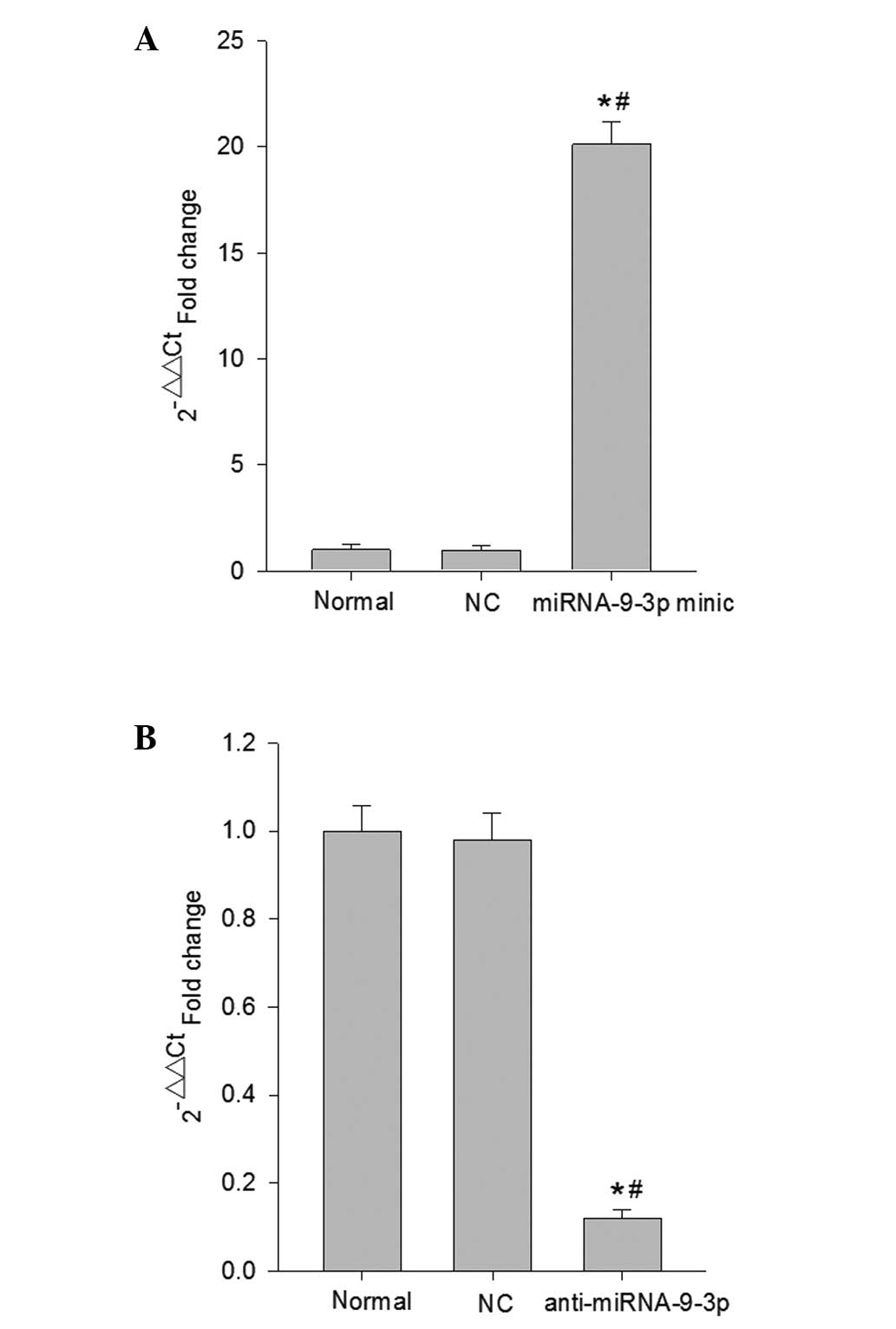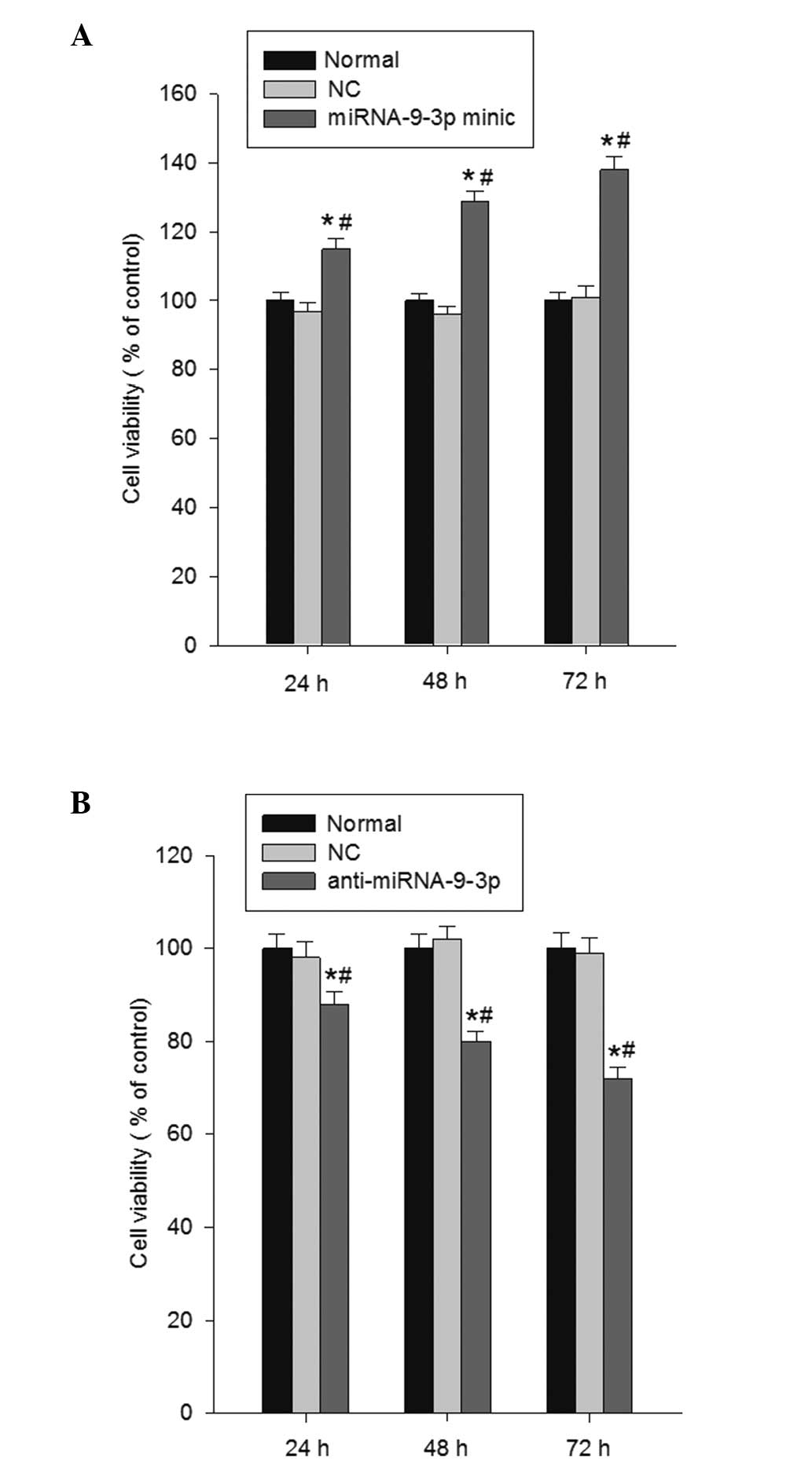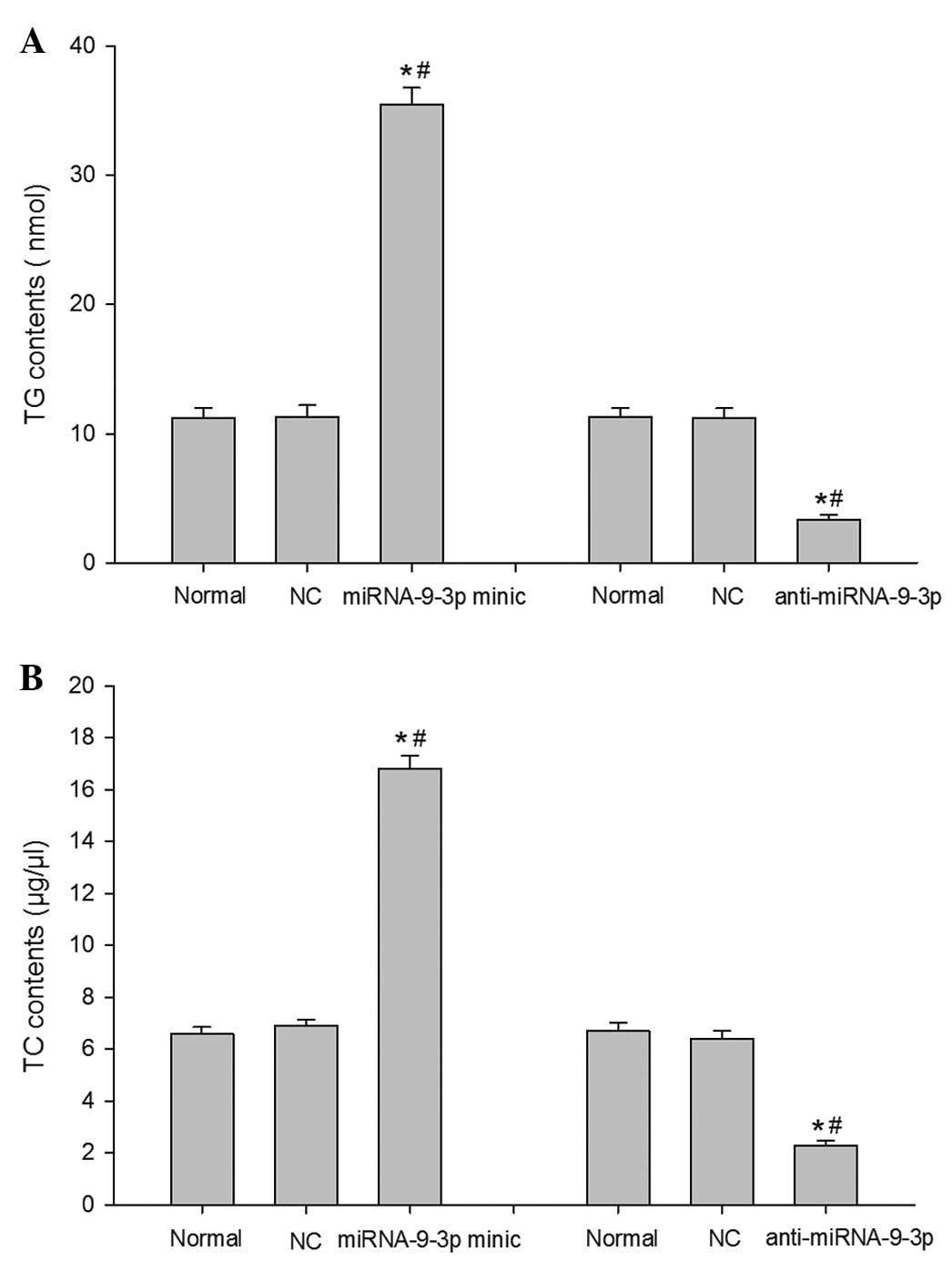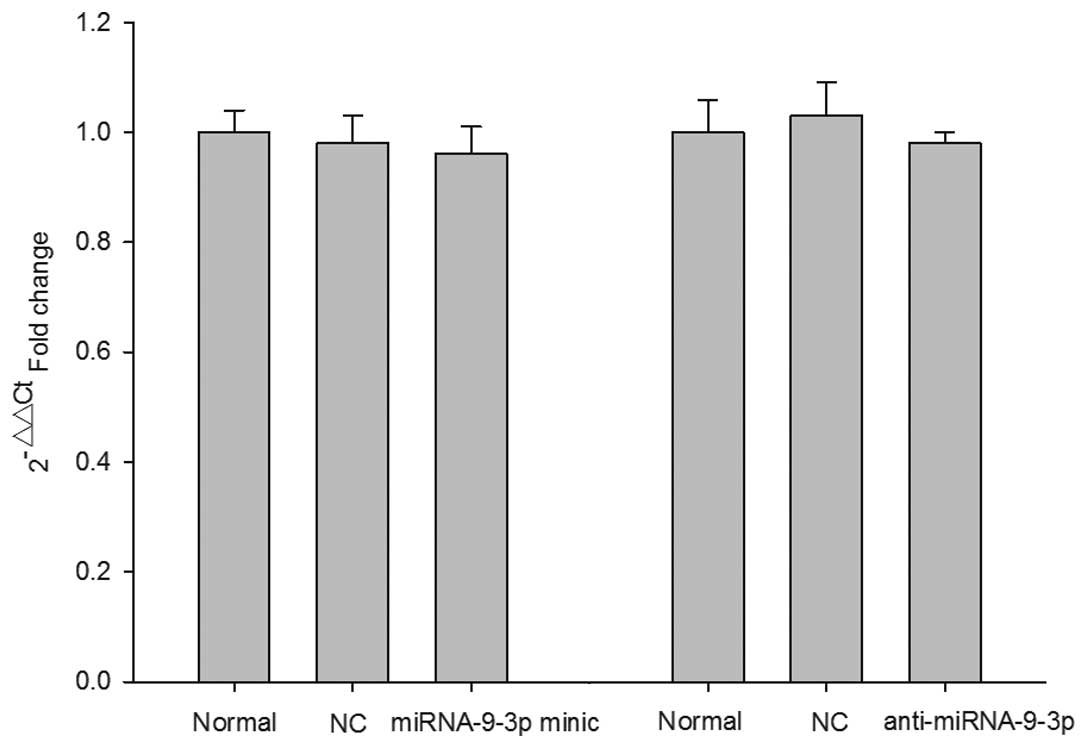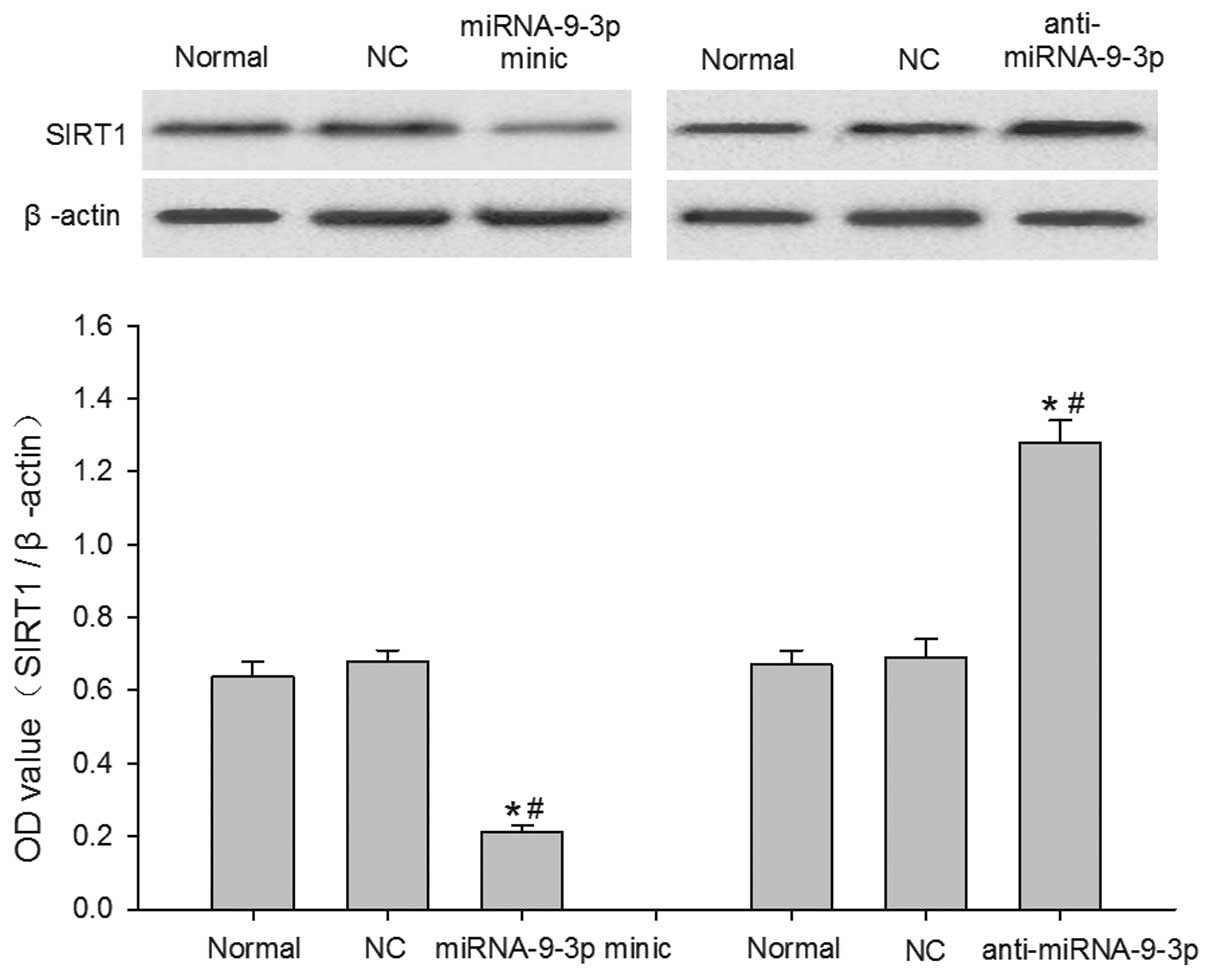Inhibition of microRNA-9-3p reduces lipid accumulation in HepG2 cells by targeting the expression of sirtuin type 1
- Authors:
- Published online on: September 25, 2015 https://doi.org/10.3892/mmr.2015.4373
- Pages: 7742-7748
Abstract
Introduction
Diabetes mellitus (DM) is a common endocrine and metabolic disease, and presents a major medical problem worldwide. The World Health Organization has predicted that DM will be the seventh leading cause of mortality by 2030 (1). In addition, it is the underlying cause of microvascular disorders, including macrovascular diseases, diabetic nephropathy and retinopathy (2). With the rapid development of social economy and continuous improvement of living standards, the prevalence of DM continues to increase. Currently, >347,000,000 individuals worldwide have beene diagnosed with DM (3). Type 2 DM (T2DM) accounts for 90–95% of all these cases. It leads to a higher risk of chronic kidney disease) (4), which may develop into end-stage renal disease and has serious consequences on morbidity and the mortality rates in this population. It is known that effective glycemic control may delay the deterioration in kidney function (5). T2DM is also one of the leading causes of cardiovascular disease, as atherosclerosis is the important pathological mechanism underlying macrovascular disease in T2DM, resulting in major life-threatening events, including myocardial infarction and stroke (6). Furthermore, clinical investigations have suggested that certain intensive therapies are ineffective in the prevention of cardiovascular-associated mortality in T2DM (7). Atherosclerosis in diabetic patients has a complex pathogenesis, which is initiated and modified by environmental risk factors and a number of genes, several of which remain to be elucidated (8). The overall genetic contribution is reported to be ~50–70%, and a substantial number of genes have been reported to be associated with T2DM (9–11). To date, a number of the most important mechanisms have been reported, including lipid metabolism disorders (12), endothelial dysfunction (13), chronic inflammation (14) and imbalance in redox homeostasis (15). Notably, lipid metabolism disorders are critical in atherosclerosis in T2DM patients.
MicroRNAs (miRNAs) represent the largest family of short non-coding RNA molecules, with a length of 19–23 nucleotides (16). It is well known that miRNAs regulate the expression of target genes in a post-transcriptional manner, through incomplete base pairing with the 3′-untranslated region of target mRNAs, inhibiting translation and/or causing mRNA degradation (17). These may contribute to the regulation of a wide variety of cellular functions. It is now well established that miRNAs account for ~1% of predicted genes in higher eukaryotic genomes, and that up to 30% of protein-coding genes may be regulated by miRNAs (18). In addition, previous studies have demonstrated that miRNAs are critical regulators of cell cycle, proliferation, differentiation, development and apoptosis during embryogenesis (16,19,20). As well as in the cell, miRNAs also exists in the circulatory system, therefore, circulating miRNAs in the plasma are expected to become novel biomarkers for molecular diagnostic and therapeutic agents for various disease.
In a previous study (21), high throughput gene chips were used to screen differential gene expression profiles in healthy controls, patients with T2DM and its complication with patients with unstable angina. The findings indicated that the occurrence of T2DM is a complicated and dynamic process affected by various miRNAs. Among the differentially expressed miRNAs, miR-9-3p was one of the genes with the most significant difference in expression. To the best of our knowledge, there are no reports evaluating the association between miR-9-3p and lipid metabolism in T2DM combined with atherosclerosis. It is well-known that the liver, as the main organ of energy metabolism, is the most frequently involved organ in glucose and lipid metabolic disorders (22). HepG2 cell lines have been used to examine lipid metabolism disorder in several diseases. Therefore, the aim of the present study was to evaluate the effects of miRNA-9-3p on lipid metabolism in HepG2 cells, and investigate its molecular mechanisms by cell transfection, reverse transcription-quantitative polymerase chain reaction (RT-qPCR) and western blot analyses.
The present study revealed that miRNA-9-3p has an important role in development of T2DM, indicating its potential as a therapeutic target. The future applications of miRNA-based diagnostics and therapeutics in metabolic diseases requires further research.
Materials and methods
Cell culture
The HepG2 cells were maintained in high glucose-Dulbecco's modified Eagle's medium (DMEM) (Gibco Life Technologies, Carlsbad, CA, USA), supplemented with 10% fetal bovine serum (FBS; GE Healthcare Life Sciences, Logan, UT, USA) and 1% penicillin/streptomycin (XiangBo Biological Technology Co., Ltd., Guangzhou, China) in a humidified atmosphere of 5% CO2 and 95% air at 37°C. The media was replaced every 2–3 days.
Cell transfection
The miRNA-9-3p mimic, miRNA-9-3p inhibitor (anti-miRNA-9-3p) and their corresponding negative control (NC) were purchased from Invitrogen Life Technologies (Carlsbad, CA, USA). The HepG2 cells were transfected with the miRNA-9-3p mimic (50 nM), miRNA-9-3p inhibitor (100 nM) or their negative controls for 48 h using Lipofectamine 2000 (Invitrogen Life Technologies), according to the manufacturer's instructions. The HepG2 cells were divided into a normal group, NC group, miRNA-9-3p mimic group and anti-miRNA-9-3p group.
MTT assay
Cell proliferation was determined using an MTT assay 24, 48 and 72 h following transfection. The HepG2 cells were plated in 96-well plates at a density of 3×104 per well. Subsequently, 10 µl 5 mg/ml MTT solution (Sigma-Aldrich, St. Louis, MO, USA) was added to each well of the 96-well plate, and the plates were incubated in the dark at 37°C for 2 h. The absorbance was measured at a wavelength of 490 nm with a microplate reader (BIORAD680; Bio-Rad Laboratories, Inc., Hercules, CA, USA), and the results were expressed as a percentage of the control.
Intracellular triglyceride (TG) and total cholesterol (TC) measurements
The concentrations of TG and TC in the HepG2 cells were measured using a Total cholesterol Test kit and a Triglyceride Test kit (BioVision, Inc., Milpitas, CA, USA), according to the manufacturer's instructions, based on phosphoglycerol oxidase/peroxidase enzymatic reactions. Briefly, HepG2 cells at 80% confluence were washed three times with 1 ml cold phosphate-buffered saline (PBS; Zhongshan Jinqiao Biological Technology Co., Ltd., Beijing, China). The concentrations of TG and TC were measured in the HepG2 cell lysates. The cell lysates, working liquid and distilled water blended at 37°C for 6 min. After cooling, the absorbent density was tested.
RNA extraction
Total RNA was isolated from the HepG2 cells using TRIzol reagent (Invitrogen Life Technologies) and an miRNeasy mini kit (Invitrogen Life Technologies), according to the manufacturer's instructions. The concentration and purity of total RNA samples was measured using a NanoDrop ND-1000 spectrophotometer (NanoDrop Technologies, Wilmington, DE, USA), with an average 260/280 ratio of 2.02, and an average 260/230 ratio of 1.79. RNA integrity was determined by agarose gel electrophoresis. Agarose (0.5 g; Zhongshan Jinqiao Biological Technology Co., Ltd.) was dissolved in electrophoresis buffer (50 ml; Zhongshan Jinqiao Biological Technology Co., Ltd.), and the samples were added to the gel following blending. The voltage was adjusted to 100 V, to allow RNA migration from the anode to the cathode. The gel was treated with EB dyeing liquid (Applygen Technologies Inc. Beijing, China) for 5 min.
RT-qPCR
The concentration, purity and integrity of the RNA samples in the present study met the criteria (A260/A280 ratio >2.0 and an A260/A230 ratio >1.7) for evaluation using RT-qPCR analysis. For RNA analysis, single-strand cDNA synthesis was performed using a PrimeScript II 1st strand cDNA Synthesis kit (Takara Biotechnology Co., Ltd., Dalian, China), according to the manufacturer's instructions. The reaction volume was 50 µl: RNase-DNase free water 32.5 µl, buffer 10 µl, dNTP mix (2.5 mM) 4 µl, forward primer (10 µM) 1 µl, reverse primer (10 µM) 1 µl, cDNA 1 µl and PrimeStar HS DNA polymerase 0.5 µl. RT-qPCR was performed on an ABI 7500 Real-Time PCR System (Applied Biosystems, Carlsbad, CA, USA), with the following conditions: One cycle of initial denaturation at 95°C for 10 min; followed by 40 cycles of 95°C for 15 sec and 60°C for 1 min. The primers designed in the present study (Sangon Biotech Co., Ltd., Shanghai, China) were as follows: sirtuin type 1 (SIRT1), sense 5′-CTACTGGTCTTACTTTGAGGG-3′, and antisense 5′-CAAGGGATGGTATTTATGCT-3′; and GAPDH, sense 5′-TCCACCACCCTGTTGCTGTA-3′ and anti-sense 5′-ACCACAGTCCATGCCATCAC-3′. GAPDH was used as an internal control. The threshold cycle (Ct), defined as the cycle at which PCR amplification reached a significant value, was determined as the mean value. The relative expression levels for each mRNA were determined using the 2−ΔΔCt method (23).
Western blot analysis
The cells were washed in fresh PBS, homogenized in radioimmunoprecipitation assay lysis buffer (Sigma-Aldrich) containing protease inhibitors (Roche Diagnostics, Indianapolis, IN, USA) and centrifuged at 10,000 x g for 15 min at 4°C. Protein concentration was determined using a Bio-Rad protein assay reagent (Bio-Rad Laboratories, Inc.). Equal quantities of total protein (40 µg) were subjected to electrophoreses on 10% SDS-PAGE (OriGene Technologies, Inc., Beijing, China), and then transferred onto polyvinylidene difluoride membranes (Roche Diagnostics GmbH, Mannheim, Germany). The membranes were blocked with 5% non-fat dry milk in Tris-buffered saline-Tween 20 (0.1%) (TBST; Zhongshan Jinqiao Biological Technology Co., Ltd.), and incubated with mouse anti-SIRT1 monoclonal antibody (A-4111-100; 1:200; Abcam, Cambridge, MA, USA) or mouse anti-β-actin monoclonal antibody (sc-47778; 1:500; Abcam) at 37°C for 2 h. Subsequently, the proteins were incubated with the corresponding horseradish peroxidase-conjugated secondary antibodies (111-035-003; 1:5,000; Abcam) at 37°C for 1 h and then washed three times with TBST for 15 min. The proteins were detected using an enhanced chemi luminescence (ECL) system (GE Healthcare Life Sciences). Densitometric quantification of the bands was performed using ImageJ software (version 1.41; National Institutes of Health, Bethesda, MD, USA). The loading volume of each sample was normalized by the β-actin protein band density.
Statistical analysis
Statistical analysis in the present study was performed using SPSS (version 18.0; SPSS, Inc., Chicago, IL, USA). All data from the experiments are presented as the mean ± standard error of the mean. Significant differences in the mean values were evaluated using Student's t-test, and one-way analysis of variance was performed to compare the means among groups. P<0.05 was considered to indicate a statistically significant difference.
Results
Expression of miRNA-9-3p in HepG2 cells
To determine the potential cellular effects of miRNA-9-3p on HepG2 cells, the HepG2 cells were transfected with the miRNA-9-3p mimic or miRNA-9-3p inhibitor, and their NCs for 48 h. To confirm whether miR-9-3p was upregulated or downregulated in the HepG2 cells, the expression levels of miRNA-9-3p in the HepG2 cells were determined using RT-qPCR analysis (Fig. 1). The results revealed that miRNA-9-3p was expressed at significantly higher levels in the HepG2 cells transfected with the miRNA-9-3p mimic, compared with the levels in the normal control group and NC group (P<0.05; Fig. 1A). By contrast, miRNA-9-3p was downregulated in the HepG2 cells transfected with the miRNA-9-3p inhibitor, compared with the normal control group and NC group (P<0.05;Fig. 1B).
Effects of miRNA-9-3p on HepG2 cell proliferation
The present study investigated the effect of miRNA-9-3p on cell proliferation using MTT growth assays at 24, 48 and 72 h post-transfection. The data revealed that miRNA-9-3p overexpression significantly enhanced cell proliferation, compared with the normal group and NC group (P<0.05; Fig. 2A). However, in the HepG2 cell lines, transfection with the miRNA-9-3p inhibitor markedly inhibited cell proliferation (P<0.05; Fig. 2B). Collectively, these results demonstrated that the inhibition of miRNA-9-3p reduced the growth of the HepG2 cells.
Effects of miRNA-9-3p on the levels of TG and TC in HepG2 cells
Subsequently, the present study analyzed the effect of miRNA-9-3p on lipid accumulation in the HepG2 cells. The TG and TC contents in the cells were measured using phospho-glycerol oxidase/peroxidase enzymatic reactions. As shown in Fig. 3A and B, the levels of TG and TC in the miRNA-9-3p group were significantly increased, compared with the normal group an NC group (P<0.05). By contrast, transfection with the miRNA-9-3p inhibitor caused downregulation in the levels of TG and TC (P<0.05). These results indicated that inhibition of the expression of miRNA-9-3p significantly decreased the TG and TC contents, and relieved lipid deposition in the HepG2 cells.
Effects of miRNA-9-3p on the expression of SIRT1 mRNA in HepG2 cells
RT-qPCR analysis of the mRNA levels of SIRT1 was performed 48 h post-transfection. As shown in Fig. 4, the RT-qPCR results demonstrated no significant difference in the mRNA expression levels of SIRT1 relative to the mRNA expression of GAPDH in any group.
Effects of miRNA-9-3p on the protein expression of SIRT1 in HepG2 cells
The protein expression of SIRT1 was analyzed using western blot analysis 48 h post-transfection. The data were normalized to the expression of β-actin. As shown in Fig. 5, the protein levels of SIRT1 were significantly decreased in the miRNA-9-3p-transfected HepG2 cells, compared with the cells in the normal group and NC group (P<0.05). However, the protein levels of SIRT1 were significantly increased when miRNA-9-3p was inhibited via transfection with anti-miRNA-9-3p, compared with the normal group and NC group (P<0.05). These results indicated that the protein expression of SIRT1 is endogenously regulated by miRNA-9-3p in HepG2 cells, suggesting that the expression of SIRT1 was post-transcriptionally regulated by miRNA-9-3p in the HepG2 cells.
Discussion
miRNAs are a group of small non-coding RNAs, which modulate the expression of target genes (24). Increasing evidence has revealed that miRNAs are critical in cell cycle regulation, cell differentiation, proliferation and apoptosis (25,26). miRNAs control these cellular biological functions by targeting the expression of genes. Therefore, the understanding and elucidation of functional targeted genes is a focus of investigations. Additionally, miRNAs are involved in several physiological and pathological processes as negative regulators. It has been reported that miRNAs are important role in insulin signaling and insulin secretion, however, the association between miRNAs and insulin resistance remains to be fully elucidated (27). In HepG2 cells lines, a previous study demonstrated that the overexpression of miRNA-145 inhibits glucose uptake, decreases the phosphorylation of protein kinase B (Akt) and insulin receptor substrate-1 (IRS-1), and induces resistin-induced insulin resistance (28). The IRS-1/phosphoinositide 3-kinase (PI3K)/AKT pathway is the predominant insulin signaling pathway involved in the regulation of blood glucose in T2DM. Another study revealed that miRNA-126 overexpression inhibited the PI3K/AKT pathway by regulating the expression of IRS-1, suggesting that miRNA-126 may be associated with glucose metabolism (29). The knockout of miRNA-375 in mice reduces the secreting ability of pancreatic islet B cells, causing insulin resistance and severe clinical symptoms (30), whereas the overexpression of miRNA-29a and miRNA-29b may inhibit insulin induced glucose uptake (31). In previous years, studies have reported that miRNA not only directly regulates insulin secretion, pancreatic development and pancreatic islet cell differentiation, but also indirectly regulates lipid metabolism and is involved in diabetes and its complications (32,33,34). However, whether miRNAs are involved in lipid metabolism in diabetes remain to be elucidated. Therefore, the purpose of the present study was to investigated whether miRNA-9-3p is involved in the process of lipid metabolism.
The human miRNA-9 gene locates on chromosome 15, and includes miRNA-9-3p and miRNA-9-5p. miRNA-9, with a brain source, is highly expressed in the nervous system and is conserved among species, exhibiting 100% similarity between Drosophila melanogaster and vertebrates (35). miRNA-9 has been demonstrated to be crucial in the repair of the myelin sheath following hypoxic-ischemic brain damage (36). Several studies have demonstrated that miRNA-9 regulates the differentiation of oligodendrocyte progenitor cells by regulating serum response factor (37), and maintain myelinogenesis (38). Importantly, the expression of miR-9-3p in islet β cells is involved in the physiological processes of insulin secretion and glucose metabolism (39). A study by Plaisance demonstrated that miR-9-3p overexpression increased the secretion of granuphilin-a protein, and reduced the exocrine abilities of the islet β cells (40). In addition, miRNA-9-3p in the plasma may be involved in cholesterol metabolism and angiogenesis, adjusting the biological function of the myocardium (41). However, whether there is a regulatory association between miRNA-9-3p and lipid metabolism disorder in T2DM remains to be elucidated.
In the present study, the effect of miRNA-9-3p on lipid accumulation in the HepG2 cells was examined by transfection of miRNA-9-3p minic, miRNA-9-3p inhibitor and their corresponding NCs into HepG2 cells. For the first time, to the best of our knowledge, the present study demonstrated that the inhibition of miRNA-9-3p suppressed the proliferation of HepG2 cells and significantly decreased TG and TC contents, reducing lipid accumulation in the HepG2 cells. These results indicated that miRNA-9-3p may offer potential as a therapeutic target for diseases associated with lipid metabolism. Subsequent investigations aim to identify biological or molecular tools to alter the expression of miRNA-9-3p for further elucidation of its function and therapeutic implications.
To examine the molecular mechanisms underlying the inhibition of lipid deposition, the present study assessed the expression of SIRT1, at mRNA and protein levels, in the HepG2 cells. The results of the RT-qPCR and western blot analyses revealed that the inhibition of miRNA-9-3p upregulated the protein expression of SIRT1 protein, but had no effect on the mRNA expression of SIRT1. SIRT1 is an NAD+-dependent deacetylase, which has been linked to the regulation of cell aging, life span and energy metabolism (42). SIRT1 function has been reported to regulate a wide range of cellular functions affecting metabolic homeostasis. SIRT1 not only exerts anti-oxidative, anti-apoptotic, and anti-inflammatory effects against cellular injury, it also inhibits sugar dysplasia effects and improves insulin sensitivity in liver, muscle and adipose tissue (43-45). Furthermore, the activation and upregulation of SIRT1 may be beneficial in age-associated disorders, including T2DM and neurodegenerative diseases (46). Similarly, down-regulation in the expression of SIRT1 has been observed in insulin-resistant subjects (47). In liver tissue, SIRT1 is key in the regulation of lipid metabolism balance. Lovis et al (48) found that SIRT1-knockout in the liver increases the level of glucose in the plasma, reduces insulin sensitivity and upregulates the levels of free fatty acids and cholesterol. These effects may be associated with the downregulation of ABCA1 and low density lipoprotein receptor (LDLR), reported by Balasubramanyam et al (49). In addition, Adlakha et al (50) revealed that miRNA-128 regulated lipid metabolism by targeting the expression of SIRT1 in HepG2 cells. These findings indicate that the expression SIRT1 regulates lipid metabolism. Therefore, maintaining SIRT1 levels or stimulating upregulation in the expression of SIRT1 may be beneficial in the treatment of a variety of diseases with lipid metabolic disorders.
In conclusion, the findings of the present study indicated that the inhibition of miRNA-9-3p exerted a regulatory effect on lipid accumulation, reducing TG and TC contents, by regulating the protein expression of SIRT1 in the HepG2 cells. This novel evidence may assist in understanding the potential roles of miRNA-9-3p in T2DM, and supports the possibility of a synthetic inhibitor of miRNA-9-3p as a novel therapeutic strategy for lipid metabolism disorder in T2DM.
Acknowledgments
The present study was supported by a grant from the Scientific Research Fund Project of Hebei Province (grant. no. 20130310).
Abbreviations:
|
DM |
diabetes mellitus |
|
T2DM |
type 2 diabetes mellitus |
|
miRNAs |
microRNAs |
|
SIRT1 |
sirtuin type 1 |
|
TG |
triglycerides |
|
TC |
total cholesterol |
|
RT-qPCR |
reverse transcription-quantitative polymerase chain reaction |
References
|
Ludovico O, Carella M, Bisceglia L, Basile G, Mastroianno S, Palena A, De Cosmo S, Copetti M, Prudente S and Trischitta V: Identification and clinical characterization of adult patients with multigenerational diabetes mellitus. PLoS One. 10:e01358552015. View Article : Google Scholar : PubMed/NCBI | |
|
Zhou Y, Fang R, Liu LH, Chen SD and Tang HD: Clinical characteristics for the relationship between type-2 diabetes mellitus and cognitive impairment: A cross-sectional study. Aging Dis. 6:236–244. 2015. View Article : Google Scholar : PubMed/NCBI | |
|
García ALM, Villarreal RE, Galicia RL, Martínez GL and Vargas DER: The cost of polypharmacy in patients with type 2 diabetes mellitus. Rev Med Chil. 143:606–611. 2015.In Spanish. View Article : Google Scholar | |
|
National Kidney Foundation: KDOQI Clinical Practice Guideline for Diabetes and CKD: 2012 Update. Am J Kidney Dis. 60:850–886. 2012. View Article : Google Scholar : PubMed/NCBI | |
|
Perkovic V, Heerspink HL, Chalmers J, Woodward M, Jun M, Li Q, MacMahon S, Cooper ME, Hamet P, Marre M, et al: Intensive glucose control improves kidney outcomes in patients with type 2 diabetes. Kidney Int. 83:517–523. 2013. View Article : Google Scholar : PubMed/NCBI | |
|
Madonna R and De Caterina R: Cellular and molecular mechanisms of vascular injury in diabetes-part I: Pathways of vascular disease in diabetes. Vasc Pharmacol. 54:68–74. 2011. View Article : Google Scholar | |
|
Duckworth W, Abraira C, Moritz T, Reda D, Emanuele N, Reaven PD, Zieve FJ, Marks J, Davis SN, Hayward R, et al: Glucose control and vascular complications in veterans with type 2 diabetes. New Engl J Med. 360:129–139. 2009. View Article : Google Scholar | |
|
Li H, Feng SJ, Su LL, Wang W, Zhang XD and Wang SX: Serum hepcidin predicts uremic accelerated atherosclerosis in chronic hemodialysis patients with diabetic nephropathy. Chin Med J (Engl). 128:1351–1357. 2015. View Article : Google Scholar | |
|
Talmud PJ, Hingorani AD, Cooper JA, Marmot MG, Brunner EJ, Kumari M, Kivimäki M and Humphries SE: Utility of genetic and non-genetic risk factors in prediction of type 2 diabetes: Whitehall II prospective cohort study. BMJ. 340:b48382010. View Article : Google Scholar : PubMed/NCBI | |
|
Li H, Gan W, Lu L, Dong X, Han X, Hu C, Yang Z, Sun L, Bao W, Li P, et al: A genome-wide association study identifies GRK5 and RASGRP1 as type 2 diabetes loci in Chinese Hans. Diabetes. 62:291–298. 2013. View Article : Google Scholar | |
|
Wang C, Li L, Wang L, Ping Z, Flory MT, Wang G, Xi Y and Li W: Evaluating the risk of type 2 diabetes mellitus using artificial neural network: An effective classification approach. Diabetes Res Clin Pract. 100:111–118. 2013. View Article : Google Scholar : PubMed/NCBI | |
|
Watanabe T, Hirata M, Yoshikawa Y, Nagafuchi Y, Toyoshima H and Watanabe T: Role of macrophages in atherosclerosis. Sequential observations of cholesterol-induced rabbit aortic lesion by the immunoperoxidase technique using monoclonal antimacrophage antibody. Lab Invest. 53:80–90. 1985.PubMed/NCBI | |
|
Werns SW, Walton JA, Hsia HH, Nabel EG, Sanz ML and Pitt B: Evidence of endothelial dysfunction in angiographically normal coronary arteries of patients with coronary artery disease. Circulation. 79:287–291. 1989. View Article : Google Scholar : PubMed/NCBI | |
|
Hansson GK: Immune and inflammatory mechanisms in the development of atherosclerosis. Br Heart J. 69(Suppl 1): S38–S41. 1993. View Article : Google Scholar : PubMed/NCBI | |
|
Guzik B, Sagan A, Ludew D, Mrowiecki W, Chwała M, Bujak-Gizycka B, Filip G, Grudzien G, Kapelak B, Zmudka K, et al: Mechanisms of oxidative stress in human aortic aneurysms-association with clinical risk factors for atherosclerosis and disease severity. Int J Cardiol. 168:2389–2396. 2013. View Article : Google Scholar : PubMed/NCBI | |
|
Kim YK: Extracellular microRNAs as biomarkers in human disease. Chonnam Med J. 51:51–57. 2015. View Article : Google Scholar : PubMed/NCBI | |
|
van Kouwenhove M, Kedde M and Agami R: MicroRNA regulation by RNA-binding proteins and its implications for cancer. Nature reviews Cancer. 11:644–656. 2011. View Article : Google Scholar : PubMed/NCBI | |
|
Ross JS, Carlson JA and Brock G: miRNA: The new gene silencer. Am J Clin Pathol. 128:830–836. 2007. View Article : Google Scholar : PubMed/NCBI | |
|
Hammond SM: An overview of microRNAs. Adv Drug Deliv Rev. 87:3–14. 2015. View Article : Google Scholar : PubMed/NCBI | |
|
Rui W, Bing F, Hai-Zhu S, Wei D and Long-Bang C: Identification of microRNA profiles in docetaxel-resistant human non-small cell lung carcinoma cells (SPC-A1). J Cell Mol Med. 14:206–214. 2010. View Article : Google Scholar | |
|
Ortega FJ, Mercader JM, Moreno-Navarrete JM, Rovira O, Guerra E, Esteve E, Xifra G, Martínez C, Ricart W, Rieusset J, et al: Profiling of circulating microRNAs reveals common microRNAs linked to type 2 diabetes that change with insulin ensitization. Diabetes Care. 37:1375–1383. 2014. View Article : Google Scholar | |
|
Stachowiak G, Pertyński T and Pertyńska-Marczewska M: Metabolic disorders in menopause. Prz Menopauzalny. 14:59–64. 2015.PubMed/NCBI | |
|
Bubner B and Baldwin IT: Use of real-time PCR for determining copy number and zygosity in transgenic plants. Plant Cell Rep. 23:263–271. 2004. View Article : Google Scholar : PubMed/NCBI | |
|
Bartel DP: MicroRNAs: Target recognition and regulatory functions. Cell. 136:215–233. 2009. View Article : Google Scholar : PubMed/NCBI | |
|
O'Connell RM, Rao DS, Chaudhuri AA and Baltimore D: Physiological and pathological roles for microRNAs in the immune system. Nat Rev Immunol. 10:111–122. 2010. View Article : Google Scholar : PubMed/NCBI | |
|
Cimmino A, Calin GA, Fabbri M, Iorio MV, Ferracin M, Shimizu M, Wojcik SE, Aqeilan RI, Zupo S, Dono M, et al: miR-15 and miR-16 induce apoptosis by targeting BCL2. P Natl Acad Sci USA. 102:13944–13949. 2005. View Article : Google Scholar | |
|
Yang WM, Jeong HJ, Park SY and Lee W: Saturated fatty acid-induced miR-195 impairs insulin signaling and glycogen metabolism in HepG2 cells. FEBS Lett. 588:3939–3946. 2014. View Article : Google Scholar : PubMed/NCBI | |
|
Kent OA, McCall MN, Cornish TC and Halushka MK: Lessons from miR-143/145: The importance of cell-type localization of miRNAs. Nucleic Acids Res. 42:7528–7538. 2014. View Article : Google Scholar : PubMed/NCBI | |
|
Elmen J, Lindow M, Schütz S, Lawrence M, Petri A, Obad S, Lindholm M, Hedtjärn M, Hansen HF, Berger U, et al: LNA-mediated microRNA silencing in non-human primates. Nature. 452:896–899. 2008. View Article : Google Scholar : PubMed/NCBI | |
|
Filipowicz W, Bhattacharyya SN and Sonenberg N: Mechanisms of post-transcriptional regulation by microRNAs: Are the answers in sight? Nat Rev Genet. 9:102–114. 2008. View Article : Google Scholar : PubMed/NCBI | |
|
Kim VN: MicroRNA biogenesis: Coordinated cropping and dicing. Nat Rev Mol Cell Bio. 6:376–385. 2005. View Article : Google Scholar | |
|
Gong W, Xiao D, Ming G, Yin J, Zhou H and Liu Z: Type 2 diabetes mellitus-related genetic polymorphisms in microRNAs and microRNA target sites. J Diabetes. 6:279–289. 2014. View Article : Google Scholar : PubMed/NCBI | |
|
Rome S: Are extracellular microRNAs involved in type 2 diabetes and related pathologies? Clin Biochem. 46:937–945. 2013. View Article : Google Scholar : PubMed/NCBI | |
|
Hamar P: Role of regulatory micro RNAs in type 2 diabetes mellitus-related inflammation. Nucleic Acid Ther. 22:289–294. 2012.PubMed/NCBI | |
|
Lagos-Quintana M, Rauhut R, Yalcin A, Meyer J, Lendeckel W and Tuschl T: Identification of tissue-specific microRNAs from mouse. Curr Biol. 12:735–739. 2002. View Article : Google Scholar : PubMed/NCBI | |
|
Zhao X, He X, Han X, Yu Y, Ye F, Chen Y, Hoang T, Xu X, Mi QS, Xin M, et al: MicroRNA-mediated control of oligodendrocyte differentiation. Neuron. 65:612–626. 2010. View Article : Google Scholar : PubMed/NCBI | |
|
Buller B, Chopp M, Ueno Y, Zhang L, Zhang RL, Morris D, Zhang Y and Zhang ZG: Regulation of serum response factor by miRNA-200 and miRNA-9 modulates oligodendrocyte progenitor cell differentiation. Glia. 60:1906–1914. 2012. View Article : Google Scholar : PubMed/NCBI | |
|
Li JS and Yao ZX: MicroRNAs: Novel regulators of oligodendrocyte differentiation and potential therapeutic targets in demyelination-related diseases. Mol Neurobiol. 45:200–212. 2012. View Article : Google Scholar : PubMed/NCBI | |
|
Ramachandran D, Roy U, Garg S, Ghosh S, Pathak S and Kolthur-Seetharam U: Sirt1 and mir-9 expression is regulated during glucose-stimulated insulin secretion in pancreatic β-islets. FEBS J. 278:1167–1174. 2011. View Article : Google Scholar : PubMed/NCBI | |
|
Plaisance V, Abderrahmani A, Perret-Menoud V, Jacquemin P, Lemaigre F and Regazzi R: MicroRNA-9 controls the expression of Granuphilin/Slp4 and the secretory response of insulin-producing cells. J Biol Chem. 281:26932–26942. 2006. View Article : Google Scholar : PubMed/NCBI | |
|
Yuva-Aydemir Y, Simkin A, Gascon E and Gao FB: MicroRNA-9: Functional evolution of a conserved small regulatory RNA. RNA Biol. 8:557–564. 2011. View Article : Google Scholar : PubMed/NCBI | |
|
Guarente L and Picard F: Calorie restriction-the SIR2 connection. Cell. 120:473–482. 2005. View Article : Google Scholar : PubMed/NCBI | |
|
Roggli E, Britan A, Gattesco S, Lin-Marq N, Abderrahmani A, Meda P and Regazzi R: Involvement of microRNAs in the cytotoxic effects exerted by proinflammatory cytokines on pancreatic beta-cells. Diabetes. 59:978–986. 2010. View Article : Google Scholar : PubMed/NCBI | |
|
Stefanowicz M, Strączkowski M and Karczewska-Kupczewska M: The role of SIRT1 in the pathogenesis of insulin resistance in skeletal muscle. Postepy Hig Med Dosw (Online). 69:63–68. 2015. View Article : Google Scholar | |
|
Kitada M and Koya D: SIRT1 in type 2 diabetes: Mechanisms and therapeutic potential. Diabetes Metab J. 37:315–325. 2013. View Article : Google Scholar : PubMed/NCBI | |
|
Lavu S, Boss O, Elliott PJ and Lambert PD: Sirtuins-novel therapeutic targets to treat age-associated diseases. Nat Rev Drug Discov. 7:841–853. 2008. View Article : Google Scholar : PubMed/NCBI | |
|
de Kreutzenberg SV, Ceolotto G, Papparella I, Bortoluzzi A, Semplicini A, Dalla Man C, Cobelli C, Fadini GP and Avogaro A: Downregulation of the longevity-associated protein sirtuin 1 in insulin resistance and metabolic syndrome: Potential biochemical mechanisms. Diabetes. 59:1006–1015. 2010. View Article : Google Scholar : PubMed/NCBI | |
|
Lovis P, Gattesco S and Regazzi R: Regulation of the expression of components of the exocytotic machinery of insulin-secreting cells by microRNAs. Biol Chem. 389:305–312. 2008. View Article : Google Scholar : PubMed/NCBI | |
|
Balasubramanyam M, Aravind S, Gokulakrishnan K, Prabu P, Sathishkumar C, Ranjan H and Mohan V: Impaired miR-146a expression links subclinical inflammation and insulin resistance in Type 2 diabetes. Mol Cell Biochem. 351:197–205. 2011. View Article : Google Scholar : PubMed/NCBI | |
|
Adlakha YK, Khanna S, Singh R, Singh VP, Agrawal A and Saini N: Pro-apoptotic miRNA-128-2 modulates ABCA1, ABCG1 and RXRα expression and cholesterol homeostasis. Cell Death Dis. 4:e7802013. View Article : Google Scholar |



